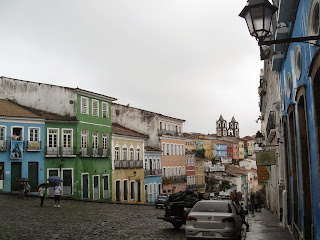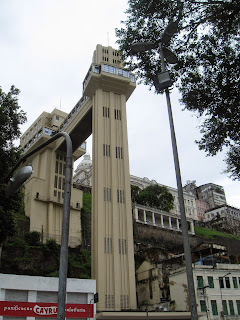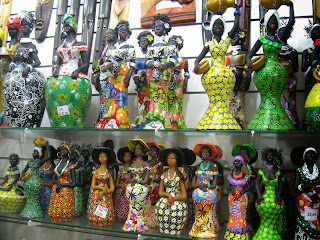I left myself one extra day after the conference, and I used it to see Salvador's historic city center, Pelourinho. The city center is on the west side of Salvador, facing All Saint's Bay. I shared a taxi over there with a few other students, and we set off to explore.
 |
| A city square in Pelourinho |
As soon as we set foot in Pelourinho, I could tell it was different from the rest of Salvador. The streets were all cobblestone; the buildings were a different architectural style and bore bright, pastel colors; there were lots of open spaces and city squares - it felt like a step back in time. Pelourinho is the most tourist-oriented part of the city, as well, so there were little cafes, restaurants, and souvenir shops. It was raining that day, so peddlers sold umbrellas and ponchos on the street. Food carts lined the streets, and there were policemen watching from their full-size vans on every corner. I felt much safer knowing men with heavy weapons and lots of training were standing by to protect me, but I couldn't help but worry that they
needed to be there. Still, there never came a time when I felt threatened.
 |
| Capoeira in Pelourinho |
There were also plenty of street performers - the standard living statues, musicians, etc. - but I was captivated by a group doing capoeira. Capoeira is a Brazilian martial art that is accompanied by traditional music and to me looks more like an elaborate dance. It's highly acrobatic, with turns, kicks and cartwheels, and in fact, capoeira is the grandfather of break-dancing. Believe it or not, I was already familiar with capoeira from my time in Oregon, since the ballet class I teach on Thursday afternoons is followed by a capoeira class. Anyway, the capoeiristas in Salvador were very good, although to my chagrin, they seemed more occupied with posing for pictures with tourists than actually performing their craft. Had they been consistently sparring with one another, I would have been content to watch for hours.
 |
| Elevador Lacerda |
My companions and I wandered through the city center for a while, had lunch in a cafe with live music, and stopped in at a museum when it started to rain. Pelourinho actually sits atop a cliff that overlooks the marina and the rest of the city below. I was told that when Salvador was first founded, the split caused locals to refer to the "lower city" and the "upper city" above or below the cliff, and in 1873, the two halves of Salvador were connected by an elevator. The elevator, known as the Elevador Lacerda, is still the most efficient way to get over the cliff, and a ride costs exactly 15 Brazilian cents (5 cents USD). We paid our coins and got in line, then crowded into an elevator car when our turn came. So many people ride the elevator in a given day that upwards of 30 people have to crowd into the slightly-larger-than-average elevator car for the 20-second ride up or down. In addition, two employees remain in the elevator car and accompany the guests; one security guard and one elevator operator (essentially, button-pusher). It may have been the most claustrophobic 20 seconds of my year, but it was a unique cultural experience, for sure.
 |
| Bahianas |
Once we reached the lower city, we headed to the Mercado de artesanias (artisan's market), another one of Salvador's highlights. The market is housed in a giant, two-story warehouse-style building. A main aisle runs down the center, and the vendors occupy small booths along the perpendicular side-aisles. Every inch of space is covered by artisanal wares. Crochet clothing, bright paintings of the city, masks, instruments, and spices are the most common items. If a vendor sees you looking at their things, they'll greet you and welcome you to look closer or step inside their booth. If you acknowledge their greeting or express any interest, it's not long before they've pulled out every item they can for you to view. The system works great if you're really interested in what the vendor is selling, but it's a bit annoying if you'd just like to browse. I actually came home with a pretty sweet painting of Pelourinho. My favorite items, though, were the traditional carved figures of Bahianas (women from Bahia). The dark-skinned women all had very similar, idealized body shape and bright, expressive dresses. I was surprised that a small but significant fraction of the Bahiana figures depicted pregnant women. I suppose it makes sense because at any time, a proportion of the female population is bound to be carrying a child, but it's not common to see pregnancy depicted so clearly in other cultures.
 |
Lembranças da Bahia join other
keychains on my backpack. |
All over the market were colorful ribbons with the words "Lembrança do senhor do Bonfim da Bahia," which translates "A reminder of the Lord of Good End of Bahia." The ribbons are exactly 47 cm long, which is the length of the arm of a Christ statue at Salvador's most famous church, the Church of Nosso Senhor do Bonfim. Ribbons were traditionally tied on the gates of the church, but nowadays, they are often worn on a person's wrist. The ribbon is secured with three knots, corresponding to three wishes, and when the ribbon falls off of its own accord, it is said that the three wishes will come true. I tied several ribbons onto my backpack and one onto my left ankle, as a reminder of Salvador, of Bahia, of my magnificent time in Brazil. What a captivating, fascinating place.
Comments
Post a Comment